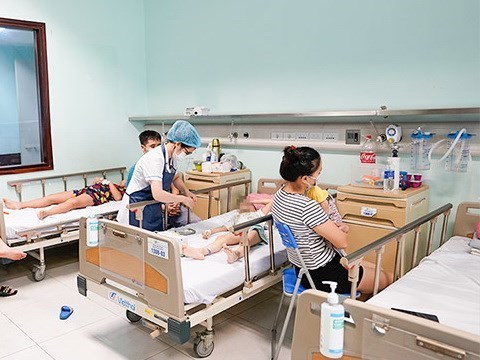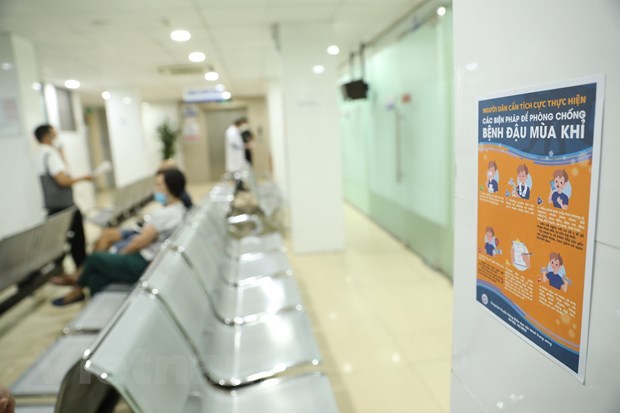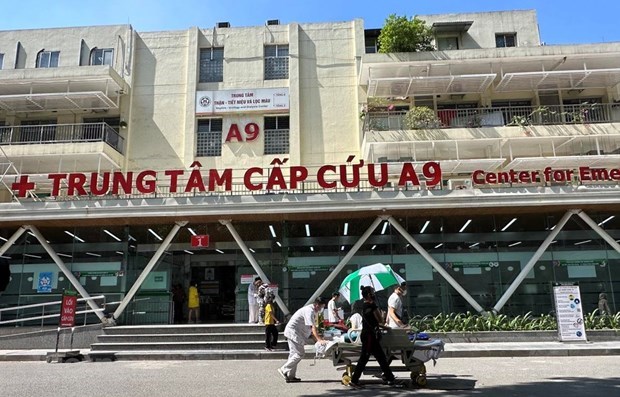 A doctor examines a child patient at the National Children’s Hospital. (Photo:VietnamPlus)
A doctor examines a child patient at the National Children’s Hospital. (Photo:VietnamPlus) Hanoi (VNA) – The Ministry of Health (MoH) has issued a plan on prevention and control of infectious diseases for this year. It aims to minimise the infection and mortality rate resulting from infectious diseases compared to the average of the 2016-2020 period and prevent outbreaks from spreading, contributing to protecting, caring and improving people’s health.
According to the ministry, the current global context of infectious diseases remains unpredictable.
Meanwhile, is still a public with possible new variants, especially when countries are reopening their borders for trade, tourism and socio-economic development.
Pathogens and virus strains also constantly evolve, potentially reducing the effectiveness of vaccines and causing outbreaks.
Dangerous infectious diseases continue to emerge across the globe, such as Marburg virus disease in Africa.
About 678 million cases of COVID-19 recorded globally and over 6.7 million people have so far died from the coronarivus outbreak.
The virus has so far infected more than 11.5 million people and caused over 43,000 deaths across Vietnam.
Vietnam recorded over 9.7 million COVID-19 infection cases last year. Many sub-variants of Omicron have been reported in the country including BA.1, BA.2, BA.4, BA.5, BA.2.12.1, BA.2.74, BA.2.75 and XBB.
 Vietnam has recorded two imported cases of monkeypox (Photo: VietnamPlus)
Vietnam has recorded two imported cases of monkeypox (Photo: VietnamPlus)The COVID-19 situation in Vietnam is still under control, however, the risks are still present, alongside other common infectious illnesses such as dengue, said the MoH.
is also likely to increase as the rainy season is forecast to come early along with increased rainfall and a high risk of infection. Emerging dangerous such as monkeypox have the potential to enter and spread in the country.
More than 371,000 dengue fever cases and 144 deaths were documented in Vietnam last year. The number of infections and deaths increased by more than five times compared to 2021.
Vietnam has recorded two imported cases of monkeypox and a human avian influenza A (H5) infection.
Local health departments have been directed to proactively take preventive measures against infectious diseases, and stay on alert to respond to possible outbreak scenarios.
They are asked to update, complete and issue a plan to ensure medical services in the context that the COVID-19 pandemic has a more dangerous strain or outbreak on a large scale, exceeding the capacity of the health system.
 Illustrative image. (Photo: VietnamPlus)
Illustrative image. (Photo: VietnamPlus)The ministry sets the goal of maintaining the achievement of polio eradication and neonatal tetanus elimination; the rate of children under one year receiving full vaccination in the expanded programme on immunisation at the communal level reaches at least 95%; and all emerging diseases are detected and promptly handled.
It also targets that all subjects of border health quarantine are monitored, examined and dealt with in line with regulations for early detection and timely handling of disease.
To this end, the MoH requires strengthening the capacity of the infectious disease prevention and control system from the central to local levels, continuing to build and perfect the organisational model to meet the requirements of tasks.
Capacity building and quality of preventive medicine and grassroots health care will be enhanced, especially in the mountainous, border and island remote areas
Health facilities will be asked to step up the improvement of the quality of health human resources, gradually ensure sufficient medical staff at all levels and they will enjoy appropriate remuneration policies./.
Source: VietnamPlus
